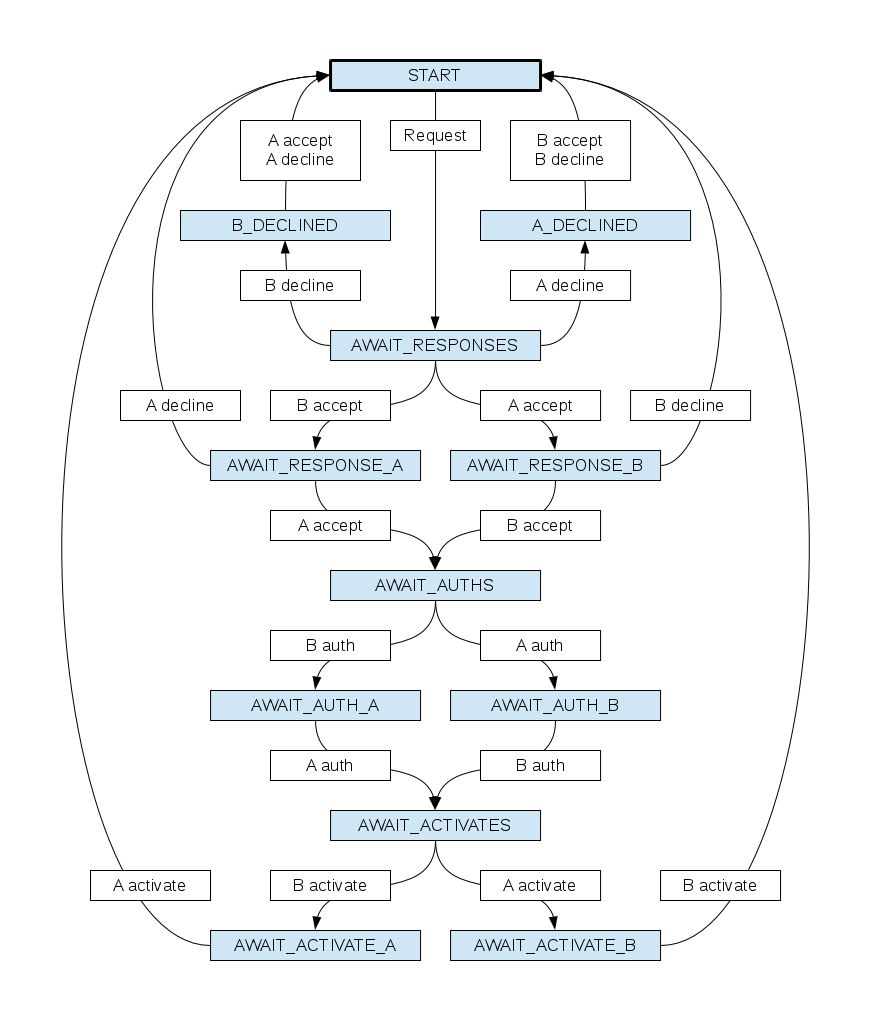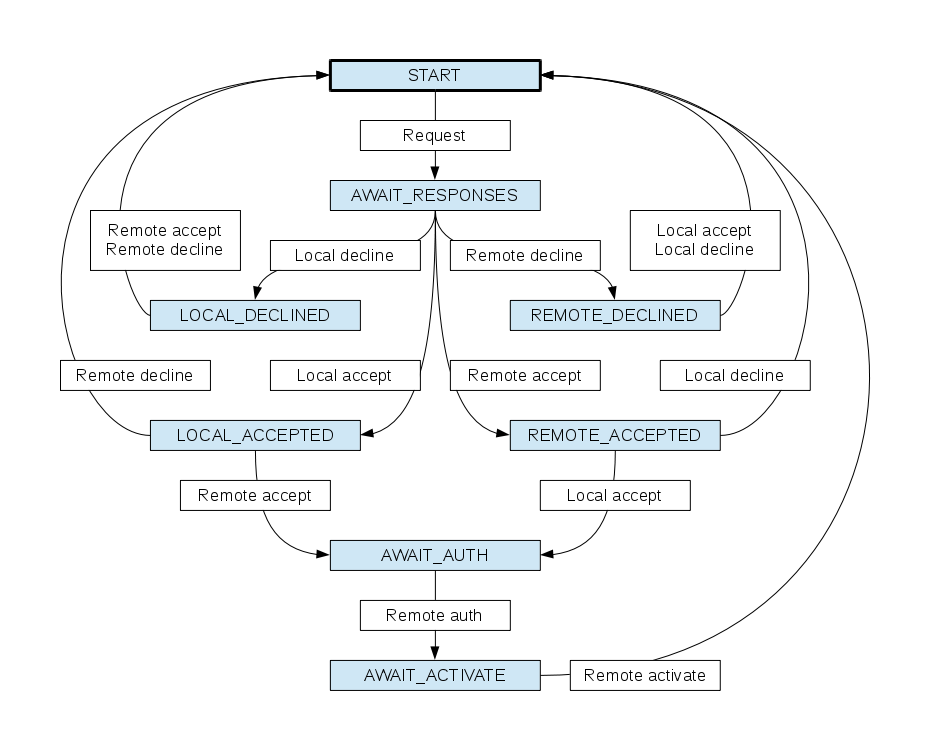Introduction Client
The introduction client is a BSP client that allows a user to introduce two contacts to each other. Each contact may accept or decline the introduction. If both contacts accept, they become each other's contacts.
Identifier
The client's identifier is org.briarproject.briar.introduction. The major version is 1.
Groups
The client uses a separate BSP group for communicating with each contact. The group descriptor is a BDF list containing the unique IDs of the contacts' identities, sorted in ascending order as byte strings.
Roles
All communication happens between two contacts, who may take different roles with respect to each introduction. The contact who initiated the introduction takes the role of introducer. The other contact takes the role of introducee. Each introduction involves two introducees, who are referred to as Alice and Bob. Alice is the introducee whose unique ID is lower, comparing the IDs as byte strings.
Sessions
The messages exchanged between a given introducer and (unordered) pair of introducees constitute a session. For the introducer, the session uses the BSP groups shared with the two introducees. For each introducee, the session uses the BSP group shared with the introducer. The introducees do not communicate directly.
The session ID is the hash of a BDF list containing the unique ID of the introducer, followed by the unique IDs of the introducees sorted in ascending order as byte strings. The hash label is org.briarproject.briar.introduction/SESSION_ID.
Message types
Message types:
The protocol uses six message types.
0: REQUEST - Sent by the introducer to each introducee. The message body is a BDF list with four elements: messageType (int), previousMessageId (unique ID or null), contact (list), and text (string or null).
previousMessageId is the unique ID of the previous message sent by the sender in this session, if any, which is a dependency.
contact is the identity of the other introducee, which is a list with three elements: formatVersion (int), nickname (string), and publicKey (raw).
text is an optional message from the introducer to the introducee explaining the introduction.
1: ACCEPT - Sent by an introducee to the introducer if the sender accepts the introduction. Forwarded by the introducer to the other introducee. The message body is a BDF list with six elements: messageType (int), sessionId (unique ID), previousMessageId (unique ID), ephemeralPublicKey (raw), timestamp (int), and transportProperties (dictionary).
Each key of the transportProperties dictionary is a transport ID. The value is a dictionary containing properties for the respective transport, where the keys and values are strings. The transportProperties dictionary may not be empty.
2: DECLINE - Sent by an introducee to the introducer if the sender declines the introduction. Forwarded by the introducer to the other introducee. The message body is a BDF list with three elements: messageType (int), sessionId (unique ID), and previousMessageId (unique ID).
3: AUTH - Sent by an introducee to the introducer if accept messages have been sent and received. Forwarded by the introducer to the other introducee. The message body is a BDF list with five elements: messageType (int), sessionId (unique ID), previousMessageId (unique ID), mac (raw), and signature (raw).
Alice calculates the master key as SHARED_SECRET("org.briarproject.briar.introduction/MASTER_KEY", bobEphemeralPublicKey, aliceEphemeralPrivateKey, clientMajorVersion, aliceEphemeralPublicKey, bobEphemeralPublicKey), where clientMajorVersion is the byte string 0x01.
Bob calculates the master key as SHARED_SECRET("org.briarproject.briar.introduction/MASTER_KEY", aliceEphemeralPublicKey, bobEphemeralPrivateKey, clientMajorVersion, aliceEphemeralPublicKey, bobEphemeralPublicKey). If the introducer forwards the ephemeral public keys without modifying them, this is the same value calculated by Alice.
The MAC sent by Alice covers a BDF list with three elements: introducerId (unique ID), aliceInfo (list), and bobInfo (list). The MAC label is org.briarproject.briar.introduction/AUTH_MAC. Alice's MAC key is KDF("org.briarproject.briar.introduction/ALICE_MAC_KEY", masterKey).
The aliceInfo and bobInfo lists contain the information sent by Alice and Bob, respectively. Each list has four elements: authorId (unique ID), timestamp (int), ephemeralPublicKey (raw), and transportProperties (dictionary).
The signature sent by Alice is SIGN("org.briarproject.briar.introduction/AUTH_SIGN", aliceIdentityPrivateKey, aliceNonce), where aliceNonce is MAC("org.briarproject.briar.introduction/AUTH_NONCE", aliceMacKey).
The MAC sent by Bob covers a BDF list with three elements: introducerId (unique ID), bobInfo (list), and aliceInfo (list). The MAC label is org.briarproject.briar.introduction/AUTH_MAC. Bob's MAC key is KDF("org.briarproject.briar.introduction/BOB_MAC_KEY", masterKey).
The signature sent by Bob is SIGN("org.briarproject.briar.introduction/AUTH_SIGN", bobIdentityPrivateKey, bobNonce), where bobNonce is MAC("org.briarproject.briar.introduction/AUTH_NONCE", bobMacKey).
Each introducee derives transport keys from the master key before sending an auth message, then deletes her ephemeral private key and the master key. The MAC keys are retained for sending and receiving activate messages.
4: ACTIVATE - Sent by an introducee to the introducer if auth messages have been sent and received. Forwarded by the introducer to the other introducee. The message body is a BDF list with four elements: messageType (int), sessionId (unique ID), previousMessageId (unique ID), and mac (raw).
The MAC sent by Alice is MAC("org.briarproject.briar.introduction/ACTIVATE_MAC", aliceMacKey). The MAC sent by Bob is MAC("org.briarproject.briar.introduction/ACTIVATE_MAC", bobMacKey).
Each introducee deletes the MAC keys after sending and receiving activate messages.
5: ABORT - Sent by any party to abort the protocol. The message body is a BDF list with three elements: messageType (int), sessionId (unique ID), and previousMessageId (unique ID).
Each introducee deletes her ephemeral private key, the master key, and the MAC keys before sending an abort message, or after receiving an abort message.
State machines
Introducer state machine:
introducer-state-machine-3a.odg
Introducee state machine:
introducee-state-machine-3a.odg
Validity policy
- A request, accept or decline message is valid if it is well-formed and its previous message (if any) is a valid message from the same sender in the same session.
- An auth message is valid if it is well-formed and its previous message (if any) is a valid message from the same sender in the same session. An introducee receiving an auth message must also validate the MAC using the other introducee's MAC key and the signature using the other introducee's identity key.
- An activate message is valid if it is well-formed and its previous message (if any) is a valid message from the same sender in the same session. An introducee receiving an activate message must also validate the MAC using the other introducee's MAC key.
Storage policy
- All messages are stored.
Sharing policy
- All local messages are shared.

